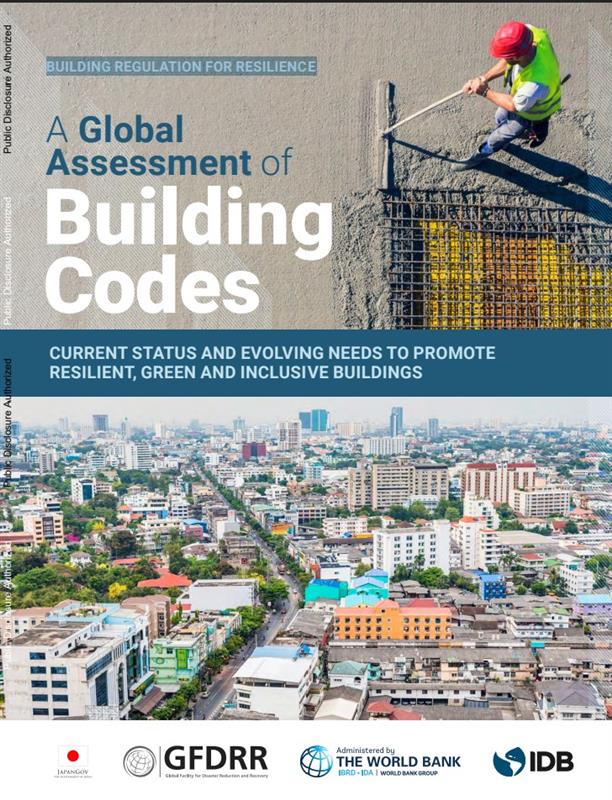
Building for Resilience: Insights from a Global Codes Assessment
A new report from the World Bank, the Global Facility for Disaster Reduction and Recovery (GFDRR), and the Inter-American Development Bank (IDB) assesses the state of building regulations in 22 nations, offering a roadmap for creating safer, greener and more inclusive communities.
The quality and resilience of the built environment are fundamental to the health and sustainability of societies worldwide. With rapid urbanization expected to push the proportion of people in cities to nearly 70 percent by 2050, a vast portion of the global building stock that will exist in the coming decades has yet to be constructed. This construction boom, largely centered in Africa, Asia and Latin America, presents a critical opportunity to lock in safety and resilience for generations to come.
A report publication, Building Regulation for Resilience: A Global Assessment of Building Codes, provides a comprehensive snapshot of where building codes stand today and offers a detailed set of recommendations for improvement. The report assesses the building codes and implementation environments of 22 countries across six geographic regions, focusing on three priority areas: structural safety and resilience, green buildings and universal accessibility.
For building safety professionals and code officials, the report’s findings offer a global perspective on shared challenges and highlight pathways to a more resilient future.

Key Findings: A Global Stocktake
The assessment reveals that while progress has been made, significant gaps remain in the development, content and implementation of building codes worldwide. Even countries with advanced codes face challenges in enforcement and keeping pace with evolving risks.
Widespread Challenges in Code Development and Implementation:
- Outdated Provisions: Many countries are operating with structural design codes that are over a decade old, failing to incorporate the latest understanding of natural hazards and climate risks.
- Gaps in Existing Building Safety: The report identifies a critical weakness across the board: a lack of provisions for the safety, assessment, rehabilitation and retrofitting of existing buildings. This leaves a vast and vulnerable portion of the built environment at risk.
- Inconsistent and Inaccessible Regulations: Codes often contain incomplete procedures or conflicting references. In many nations, obtaining access to the full set of building regulations is difficult and costly, hindering effective implementation.
- Lack of Local Tailoring: Codes are often not well-tailored to local construction practices, climate conditions, and hazards. A notable gap is the lack of simplified provisions for common types of small-scale buildings, which could significantly improve safety in informal or self-built housing sectors.
- Weak Implementation Environments: Even the best codes are ineffective without robust implementation. The study found that building control processes can benefit from enhanced efficiency and transparency, while both public and private sectors require greater capacity-building investments.
Performance Across Key Areas:
- Structural and Hazard Resilience: While most codes cover basic structural design principles, many fall short on resilience.
- Seismic and Wind: Only 59 percent of the studied countries have up-to-date, country-specific seismic hazard maps, and just 41 percent have the equivalent for wind speed. Provisions for the seismic design of nonstructural elements and ductile detailing often have significant gaps.
- Climate-Related Hazards: Provisions to address climate-related hazards like flooding, extreme heat and wildfires are rarely included in building codes. Only 27 percent of the reviewed countries had any structural provisions related to flood loading.
- Performance Objectives: Very few countries have moved beyond minimum life-safety objectives to incorporate higher performance goals, such as functional recovery, which are crucial for minimizing disruption after a disaster.
- Green Building and Universal Accessibility: The adoption of green and accessible building provisions is insufficient, and many requirements remain voluntary rather than mandatory.
- Green Provisions: While many countries have some measures for passive energy efficiency like natural ventilation, fewer than 25 percent have provisions for low-carbon design, such as the use of recycled materials.
- Universal Accessibility: Regulations are often only available online, which can gatekeep access. Additionally, provisions frequently focus on mobility challenges, with less emphasis on the needs of users with cognitive or other impairments.
A Roadmap for Action: Key Recommendations
The report provides a clear, actionable roadmap for policymakers, code development bodies and building professionals. The recommendations are designed to be a starting point for countries to enhance their regulatory frameworks.
Topic 1: Strengthen Code Development
- Set Clear Processes: Establish defined roles, responsibilities and timelines for code development and updates, supported by adequate resources.
- Tailor to Context: Ensure codes are adapted to local hazards, climate, construction practices and capacity. Adopting model codes like the International Codes® (I-Codes) is an efficient start, but requires significant effort to tailor them appropriately.
- Ensure Consistency: Verify that all provisions are complete, consistent and harmonized across different topic areas to avoid conflicts, such as between fire safety and green building measures.
Topic 2: Address Small-Scale and Existing Buildings
- Include Simplified Provisions: To promote safer construction in the informal sector, include straightforward, simplified provisions for common small-scale buildings.
- Regulate Existing Buildings: Introduce clear requirements for the modification, change of use, assessment and retrofitting of existing buildings to address risks and improve sustainability.
Topic 3: Enhance Resilience to Natural Hazards
- Update Hazard Maps: Periodically review and update country-specific seismic and wind hazard maps using the latest data and methodologies.
- Improve Design Requirements: Strengthen critical code elements, such as geotechnical provisions, ductile detailing and the design of diaphragms and nonstructural components to protect occupants and limit service disruption.
- Target Higher Performance: For critical facilities, consider including provisions aimed at limiting damage and ensuring functional recovery after a disaster, using performance-based approaches or more stringent prescriptive requirements.
Topic 4: Integrate Climate Adaptation, Green Design and Accessibility
- Incorporate Climate Provisions: Introduce measures to mitigate the impacts of extreme heat, flooding and wildfires.
- Increase Green Building Adoption: Move toward mandating key provisions for energy and water efficiency and promoting low-carbon design through the entire building lifecycle.
- Mandate Accessibility: Transition voluntary accessibility provisions to mandatory requirements where appropriate, especially for public buildings and expand provisions to cover a wider range of user needs.
Topic 5: Bolster the Implementation Environment
- Streamline Building Control: Ensure building control processes are transparent and efficient, for instance by making information and approvals available online.
- Target Resources: Optimize building control by targeting resources toward higher-risk and higher-importance buildings.
- Invest in People: Commit to continuous investment in capacity building for both public and private-sector stakeholders, supported by professional licensing and certification systems.
The Way Forward
The “Building Regulation for Resilience” report underscores that effective building codes are among the most powerful and cost-effective tools for improving the safety and resilience of the built environment. By closing the gaps in code content and strengthening the mechanisms for implementation, nations can protect their citizens, safeguard their economies and build a safer, greener and more inclusive future for generations to come.
To read the report, click here.
The International Codes® (I-Codes), developed by the International Code Council, are a family of fifteen coordinated, modern building safety codes that help ensure the design and construction of safe, sustainable, and affordable structures. The I-Codes are the most widely used and adopted set of model codes in the world. Learn more, here.






